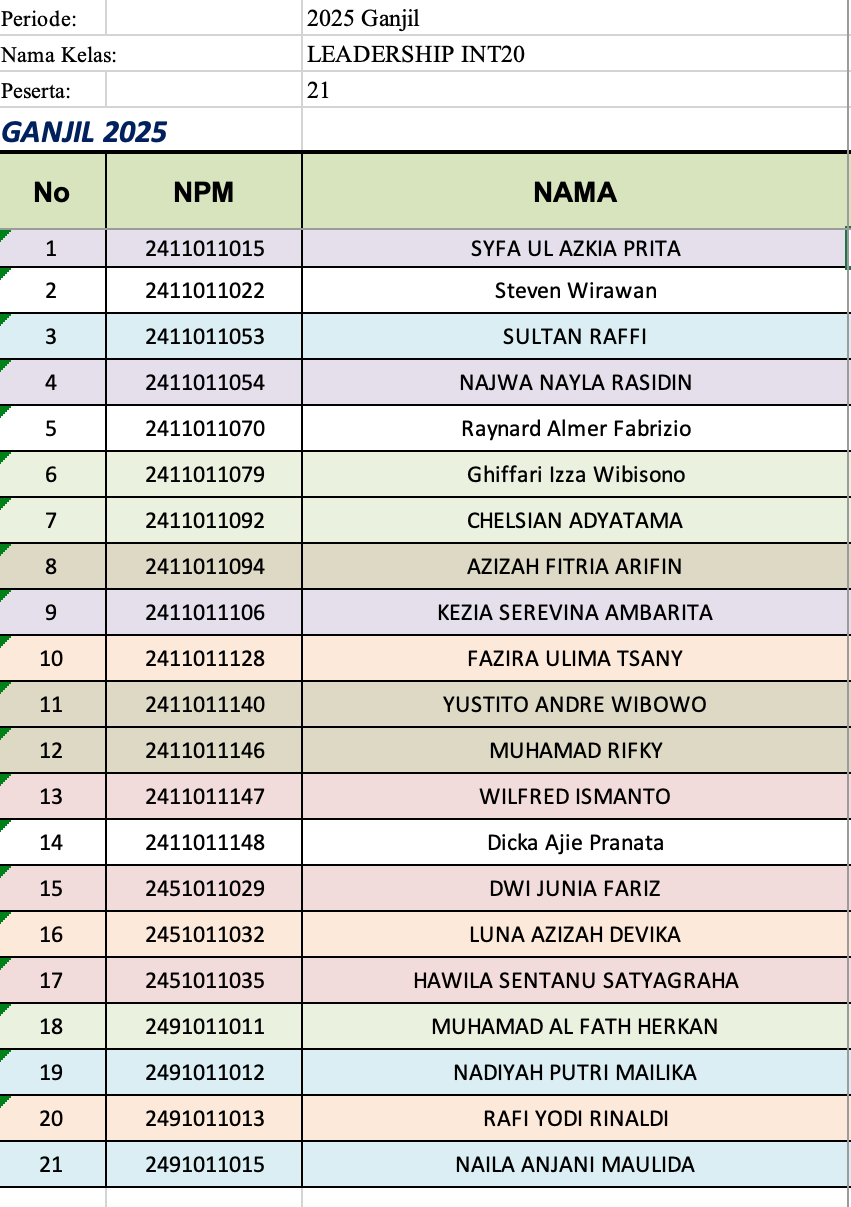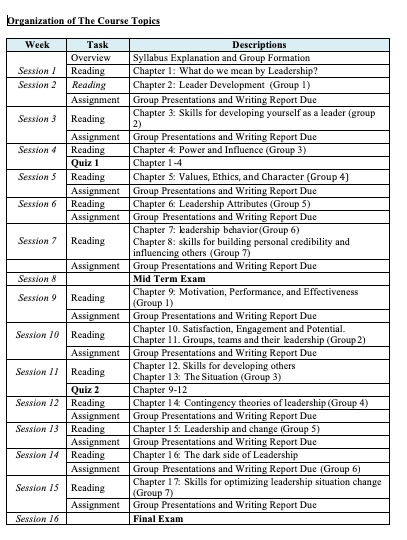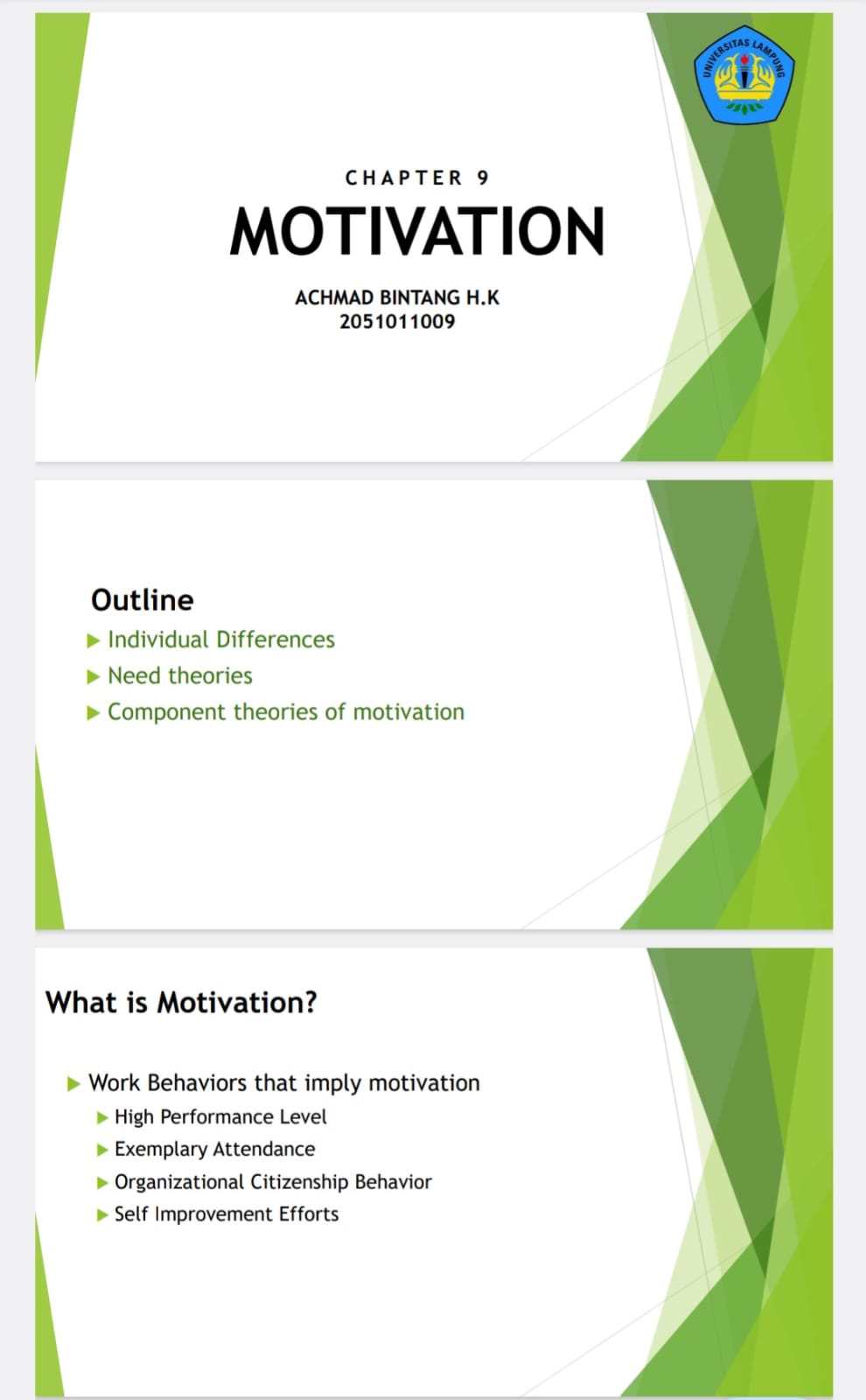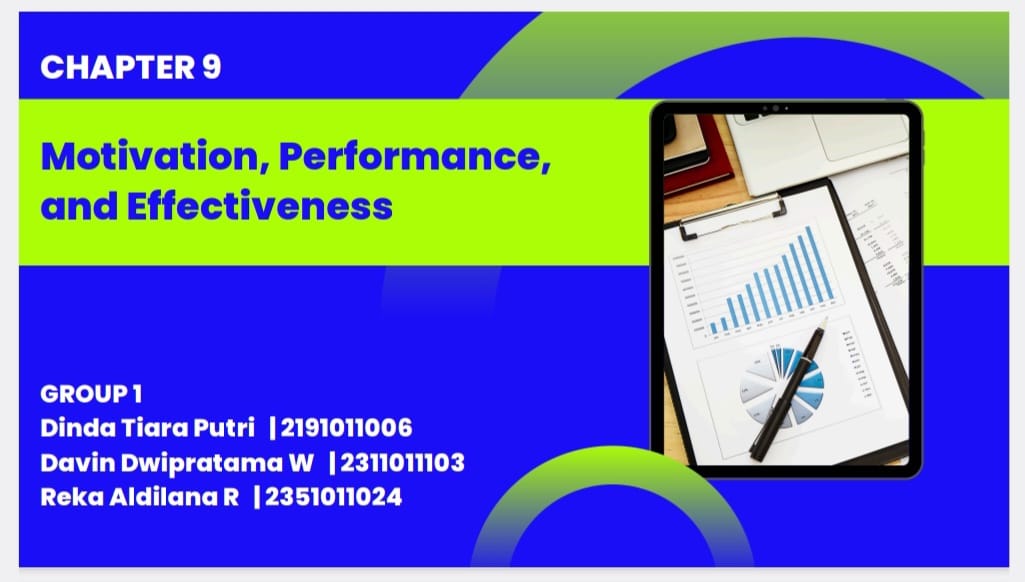Ringkasan Mingguan
Umum

LEADERSHIP COURSE
Leadership is part of management functions that occupy strategic positions in the system and hierarchy of work and responsibilities in an organization. The success or failure of an organization is one of which is determined by the leadership that leads the organization, even the back and forth of an organization is often identified with the leadership behavior of its leaders.
This lecture is about leadership in organizations. The main focus is on managerial leadership not political leadership, leadership in social movements, or informal group leadership. In this course, theoretical explanations and research results on leadership in formal organizations are presented in practical examples of managerial leadership. This Leadership course reveals and explains concepts related to leadership, tasks, and steps, ranging from environmental analysis, marketing research, understanding effective leadership behavior, leadership theories.
GREETINGS
Bismillahirohmannirohim..
Assalamualaikum Wr.Wb.....
Welcome to this new semester. Hopefully all of us will always be given health so that we can go through lectures well.
Introduce us to the teaching team for the Leadership course.
Dr. Nova Mardiana, S.E., M.M.
LIS ANDRIANI, S.E., M.Si.
We will guide you to master this course.
The first 8 meetings until Mid exam will be with Ms. Nova Mardiana
The next 8 meetings until final exam will be with Ms. Lis Andriani
Enjoy your lecture and do your best
Have good study!!Dr. NOVA MARDIANA, S.E., M.M. LIS ANDRIANI, S.E., M.Si
Hand book of Leadership
Instructions For Carrying Out Lectures
So that students can access and be able to take part in this Leadership lecture properly and smoothly, there are a number of things that need to be followed by all students, namely:
- Students can access the Leadership course at LMS Vclass Unila (vclass.unila.ac.id) via a smartphone or computer / laptop connected to an internet network.
- To be able to access (login) to the LMS Vclass Unila, students are required to have an SSO Unila account which can be obtained from UPT TIK Unila.
- Students can ask for a password from the course lecturer so they can enter as a participant.
- Students are required to use their Real Name and include the NPM as their Vclass account name. Example of an account naming format: Adi Saputra_17110897654. In addition, students are also required to display original official photos on their respective account profiles.
- After joining the virtual class in the Leadership course, students are required to read all the instructions and materials / content that the lecturer has provided for each meeting, before the lecture meeting is held.
- Students are required to actively participate in discussions held at each meeting, because this is one aspect of the final assessment.
- Students are required to work on all assignments given by the lecturer and collect according to the predetermined time.
- Students are allowed to actively ask questions in every learning activity if there are things that are still not understood from the material presented by the lecturer.
- Students are required to take a quiz which will be held two (2) times, namely at the end of the 4th and 12th meeting / week.
- Students are required to take the Mid-Semester Examination (UTS) which will be held at the 8th meeting / week.
- Students are required to take the Final Semester Examination (UAS) which will be held at the end of the lecture or meeting / week 16.

fill your report project here
Session 1; Syllabus Explanation and Group Formation & Chapter 1: What do we mean by Leadership?
INTRODUCTION
Assalamu'alaikum
Dear Student...We WILL discussed the importance of using multiple perspectives to analyze various leadership situations. It’s also true that there are multiple paths by which one’s own leadership is developed. That’s what this chapter is about: how to become a better leader. As an overview, we begin this chapter by presenting a general model that describes how we learn from experience. Next we describe how perceptions can affect a leader’s interpretation of, and actions in response to, a particular leadership situation and why reflection is important to leadership development. The chapter also examines several specific mechanisms often used to help leaders become better leaders.
PRESENTATION

Please answer following questions
Attempt: 3 timesClosing
Ya Allah...,
Thank you for loving all of us with good health so we can study today in great spirit.
Today is a great learning experience for all of us.
Please make the things that I know how to be useful and something I will remember and implement in daily life.
You have great power to makes the impossible happen.
Please allow us to be more understanding of the lesson even from before.
Thank you for allowing us to learn something new and make us richer with information.
Aamiin...
Thank you very much for your seriousness in participating in the learning.
See you next week...


Session 2; Ch 2. Leader Development
Leader Development 40
Introduction 40
The Action–Observation–Reflection Model 42 The Key Role of Perception in the Spiral
of Experience 45Perception and Observation 45 Perception and Reflection 47 Perception and Action 48
Reflection and Leadership Development 49 Single- and Double-Loop Learning 53
Making the Most of Your Leadership Experiences: Learning to Learn from Experience 54
Leader Development in College 57
Leader Development in Organizational Settings 59 Action Learning 64
Development Planning 65
Coaching 67
Mentoring 69Building Your Own Leadership Self-Image 72 Summary 74
answers this questions..
1. Explain how to building technical competence !
2. Explain how to building effective relationships with superiors !
3. Explain how to building effective relationships with peers
4. Explain how to developi planningClosing
Ya Allah...,
Thank you for loving all of us with good health so we can study today in great spirit.
Today is a great learning experience for all of us.
Please make the things that I know how to be useful and something I will remember and implement in daily life.
You have great power to makes the impossible happen.
Please allow us to be more understanding of the lesson even from before.
Thank you for allowing us to learn something new and make us richer with information.
Aamiin...
Thank you very much for your seriousness in participating in the learning.
See you next week...
Session 3; Ch 3. Skills for Developing Yourself as a Leader
Introduction 82
Your First 90 Days as a Leader 83Before You Start: Do Your Homework 83 The First Day: You Get Only One Chance
to Make a First Impression 84
The First Two Weeks: Lay the Foundation 85 The First Two Months: Strategy, Structure,and Staffing 87
The Third Month: Communicate and Drive Change 88 Learning from Experience 89
Creating Opportunities to Get Feedback 89 Taking a 10 Percent Stretch 89
Learning from Others 90
Keeping a Journal 90Having a Developmental Plan 92 Building Technical Competence 92
Determining How the Job Contributes to the Overall Mission 93
Becoming an Expert in the Job 94
Seeking Opportunities to Broaden Experiences 94Building Effective Relationships with Superiors 95 Understanding the Superior’s World 96
Adapting to the Superior’s Style 96Building Effective Relationships with Peers 97
Recognizing Common Interests and Goals 98 Understanding Peers’ Tasks, Problems, and Rewards 98 Practicing a Theory Y Attitude 99
Development Planning 99
Conducting a GAPS Analysis 100
Identifying and Prioritizing Development Needs: Gaps of GAPS 102
Bridging the Gaps: Building a Development Plan 103
Reflecting on Learning: Modifying Development Plans 105
Transferring Learning to New Environments 105Persentation
Chapter Review
Please answer questions
Closing
Ya Allah...,
Thank you for loving all of us with good health so we can study today in great spirit.
Today is a great learning experience for all of us.
Please make the things that I know how to be useful and something I will remember and implement in daily life.
You have great power to makes the impossible happen.
Please allow us to be more understanding of the lesson even from before.
Thank you for allowing us to learn something new and make us richer with information.
Aamiin...
Thank you very much for your seriousness in participating in the learning.
See you next week...
Session 4. Ch 4. POWER AND INFLUENCE
Introduction 110
Some Important Distinctions 110 Power and Leadership 114Sources of Leader Power 114
A Taxonomy of Social Power 117Expert Power 118 Referent Power 118 Legitimate Power 119 Reward Power 120 Coercive Power 121
Concluding Thoughts about French and Raven’s Power Taxonomy 124
Leader Motives 126Influence Tactics 129
Types of Influence Tactics 129
Influence Tactics and Power 130
A Concluding Thought about Influence Tactics 134Summary 136
Introduction to Power & Influence
Assalamu'alaikum wr wb
Dear students
What comes to your mind when you think about power? Do you think of a person wielding enormous authority over others? Do you think of high office? Do you think of taking others do things against their will? Is power ethically neutral, or is it inherently dangerous as Lord Acton said? (“Power corrupts, and absolute power corrupts absolutely.”) Do you think a leader’s real power is always obvious to others? What sorts of things might enhance or detract from a leader’s power? What are the pros and cons of different ways of trying to influence people? These are the kinds of issues we will explore in this chapter.
Presentation: Power & Influence
QUIZ TIME
1.Some definitions of leadership exclude reliance on formal authority or coer- cion (that is, certain actions by a person in authority may work but should not be considered leadership). What are the pros and cons of such a view?
2. Some people say it dilutes a leader’s authority if subordinates are allowed to give feedback to the leader concerning their perceptions of the leader’s perfor- mance. Do you agree?
3. Is leadership just another word for influence? Can you think of some examples of influence that you would not consider leadership?
4. Explain how to building technical competence !
5. Explain how to building effective relationships with superiors !
6. Explain how to building effective relationships with peers!
Closing
Ya Allah...,
Thank you for loving all of us with good health so we can study today in great spirit.
Today is a great learning experience for all of us.
Please make the things that I know how to be useful and something I will remember and implement in daily life.
You have great power to makes the impossible happen.
Please allow us to be more understanding of the lesson even from before.
Thank you for allowing us to learn something new and make us richer with information.
Aamiin...
Thank you very much for your seriousness in participating in the learning.
See you next week...
Session 5; Chapter 5: Values, Ethics, and Character
Introduction

Assalamu'alaikum wr wb
Dear students,
Leaders face dilemmas that require choices between competing sets of values and priorities, and the best leaders recognize and face them with a commitment to doing what is right, not just what is expedient. Of course the phrase doing what is right sounds deceptively simple. Sometimes it takes great moral courage to do what is right, even when the right action seems clear. At other times, though, leaders face complex challenges that lack simple black-and-white answers. Whichever the case, leaders set a moral example to others that becomes the model for an entire group or organization, for good or bad. Leaders who themselves do not honor truth do not inspire it in others. Leaders concerned mostly with their own advancement do not inspire selflessness in others. Leaders should internalize a strong set of ethics—principles of right conduct or a system of moral values.LEARNING OBJECTIVE
1. Importance of Values in Leadership2. Ethics and Decision-Making
3. Core Ethical Principles
4. The Importance of Character in Leadership
5. The Impact of Ethical Leadership
6. ConclusionPRESENTATION
Thank you very much for your seriousness in participating in the learning. Evaluation of your learning can be seen in the following folder.
See you next weekAnswers this questions...
1. What Are Critical Elements of Developing Ethical Leadership?
2. led Hannah and Avolio to recommend greater attention be paid to a concept they call moral potency. It has three main components. Explain about that !
3. Explain about Ten characteristics are often associated with servant leaders.
Closing
Ya Allah...,
Thank you for loving all of us with good health so we can study today in great spirit.
Today is a great learning experience for all of us.
Please make the things that I know how to be useful and something I will remember and implement in daily life.
You have great power to makes the impossible happen.
Please allow us to be more understanding of the lesson even from before.
Thank you for allowing us to learn something new and make us richer with information.
Aamiin...
Thank you very much for your seriousness in participating in the learning.
See you next week...
Session 6; Chapter 6: Leadership Attributes
Introduction

Assalamu'alaikum wr wb
Dear students,
Leadership: Enhancing the Lessons of Experience, Ninth EditionThe purpose of this chapter is to summarize what we currently know about personality, intelligence, and leadership. In other words, what does the research say about the leadership effectiveness of people who are smart, outgoing, innova- tive, and calm versus those who are dumb, shy, practical, and excitable? Do smarter people always make better leaders? Are there situations where tense and moody leaders are more effective than calm leaders? This chapter answers many common questions regarding the roles of personality, intelligence, creativity, and emotional intelligence in leadership effectiveness. As an overview, the chapter defines these four key attributes, reviews some important research findings for these attributes, and discusses the implications of this research for leadership practitioners.
PRESENTATION
Thank you very much for your seriousness in participating in the learning. Evaluation of your learning can be seen in the following folder.
See you next weekLeadership: Enhancing the Lessons of Experience, Ninth Edition
Answers this questions..-
What OCEAN personality traits, intelligence components ,or EQ components do you think would help professional sports players be more or less success- ful? Would successful coaches need the same or different personality traits and preferences? Would successful players and coaches need different traits for different sports?
-
How would you rank-order the importance of analytic intelligence, practical intelligence, creative intelligence, or emotional intelligence for politicians? Would this ranking be the same for college professors or store managers at a Walmart or Aldi store?
-
Think of all the ineffective leaders you have ever worked or played for. What attributes did they have (or, perhaps more important, lack) that caused them to be ineffective?
-
Individuals may well be attracted to, selected for, or successful in leadership roles early in their lives and careers based on their analytic intelligence. But what happens over time and with experience? Do you think wisdom, for ex- ample, is just another word for intelligence, or is it something else?
-
What role would downsizing play in an organization’s overall level of practical intelligence?
-
Weusuallythinkofcreativityasacharacteristicofindividuals,butmightsome organizations be more creative than others? What factors do you think might affect an organization’s level of creativity?
-
Can better leaders more accurately perceive and leverage emotions? How could you determine if this was so?
-
Closing
Ya Allah...,
Thank you for loving all of us with good health so we can study today in great spirit.
Today is a great learning experience for all of us.
Please make the things that I know how to be useful and something I will remember and implement in daily life.
You have great power to makes the impossible happen.
Please allow us to be more understanding of the lesson even from before.
Thank you for allowing us to learn something new and make us richer with information.
Aamiin...
Thank you very much for your seriousness in participating in the learning.
See you next week...
Session 7; Chapter 7: leadership behavior & Chapter 8: skills for building personal credibility and influencing others
Answers this questions ..
1. Explain about The Building Blocks of Skills !2. Explain about The Leadership Pipeline
3. Explain about The components of Community Leadership !
4. There are “basic” skills with which almost every leader should be equipped:
Explain about that• Building Credibility
• Communication
• Listening
• Assertiveness• Conducting Meetings
• Effective Stress Management • Problem Solving
• Improving Creativity
Closing
Ya Allah...,
Thank you for loving all of us with good health so we can study today in great spirit.
Today is a great learning experience for all of us.
Please make the things that I know how to be useful and something I will remember and implement in daily life.
You have great power to makes the impossible happen.
Please allow us to be more understanding of the lesson even from before.
Thank you for allowing us to learn something new and make us richer with information.
Aamiin...
Thank you very much for your seriousness in participating in the learning.
See you next week...
Session 8; MID TERM

Closing
Ya Allah...,
Thank you for loving all of us with good health so we can study today in great spirit.
Today is a great learning experience for all of us. Please make the things that I know how to be useful and something I will remember and implement in daily life. You have great power to makes the impossible happen. Please allow us to be more understanding of the lesson even from before. Thank you for allowing us to learn something new and make us richer with information. Aamiin...
Thank you very much for your seriousness in participating in the learning. See you next week
Session 9; Chapter 9: Motivation, Performance, and Effectiveness
OPENING
Good Afternoon Students,
Welcome to the Class of Leadership. Start from today until Final exam, I will be in charge of assisting you in learning, replacing Ms Nova. Today we will discuss about the topic "MOTIVATION".INTRODUCTION
The most important job of a leader is to motivate their employees to do outstanding work. Unfortunately, only 2 in 10 employees strongly agree that their performance is managed in a way that motivates them to do outstanding work. Managing employee performance effectively requires leaders to identify and implement strategies that keep employees motivated to continually perform well and produce outstanding work. Understanding the ways in which motivation impacts performance can help leaders land on the best strategies for increasing it and ensuring they are providing a work environment employees can feel inspired in and thrive in.
Employee motivation impacts performance in many positive ways. Motivated employees are more productive, happier at work, more committed to the vision, better collaborators, and more likely to stay with the organization. Effective performance management is essential for high motivation and high performance.
What Is Employee Motivation?
Employee motivation is the level of energy, commitment, and creativity that employees bring to their jobs and describes how invested they are in the work they do, how engaged they are with the organization’s goals, and how empowered they feel in their daily work to achieve those goals and reach their full potential.
Motivated employees adhere to certain behaviors and engage in actions that result in positive rewards that satisfy human needs. They find satisfaction in going above and beyond because they like what they do and want to do it well.
There are two types of motivation: extrinsic and intrinsic. Extrinsic motivation is motivation to participate in an activity based on meeting an external goal, earning praise or approval, winning a contest or competition, or receiving an award or payment. Intrinsic motivation is defined as doing an activity for its inherent rewards rather than for a separable consequence.
What Are the Benefits of High Employee Motivation?
Motivation drives employee success and plays a vital role in employee satisfaction, which drives performance. In turn, improved performance impacts customer satisfaction, which can fuel organizational performance.
Motivated employees are better at adapting to change and collaborating with their teammates. They are more willing to go above and beyond for a project, customer, or co-worker, and maintain a positive attitude at work. Having a team of highly motivated employees can also reduce turnover and absenteeism, boosting the team’s overall performance.
Often, managers do not realize how essential motivation is to leading well and ensuring an organization’s future success. They may even believe, mistakenly, that extrinsic motivators like compensation are enough to motivate team members to consistently perform well. But intrinsic motivators are actually a stronger predictor of performance.
While both kinds of motivation are essential, intrinsic motivation is particularly important because intrinsically motivated employees are happier in their roles and more productive. They will continue to work at an organization because they love the work they do, not just because of the paycheck.
10 FACTORS THAT INFLUENCE EMPLOYEE MOTIVATION
https://peoplethriver.com/what-are-the-factors-that-influence-employee-motivation/MOTIVATION, PERFORMANCE AND EFFECTIVENESS PPT

MOTIVATION

Session 10; Chapter 10. EMPLOYEE ENGAGEMENT & Chapter 11. TEAM DYNAMICS
Introduction
What Is Employee Engagement?
Employee engagement looks beyond if your employees are just happy. Some people will be happy to give the minimum at work and collect a paycheck. Instead, employee engagement is a way to approach and measure how fulfilled and connected your employees are to your business and its success. It’s about finding ways to create the right conditions and providing the right support so employees are committed to your company’s growth. Engagement is the behavior that results from conditions that make an employee feel fulfilled, valued, satisfied and invested in the organization’s prosperity.
What Employee Engagement is Not
Employee engagement is not just about a feeling. It’s not just a sense of happiness or satisfaction, or even liking a specific company. An employee can like a job because she gets paid well, but it doesn’t necessarily mean she’s actively engaged in her work and dedicated to helping her company grow.
Employee Engagement vs. Employee Satisfaction
Employee satisfaction doesn’t address someone’s level of commitment, motivation or involvement in an organization. Instead, it only indicates how content your employees are. For example, some employees might be satisfied doing the bare minimum to not get fired while collecting their paychecks and enjoying time off and other benefits.
Employee Engagement Employee Satisfaction How passionate employees are about their roles’ value and how committed they are to the company — this is related to how much extra effort they may perform. How content employees are with their jobs and work environment. Engaged employees are deeply involved in the work they perform. Employees can be satisfied with their job while not being engaged. Engagement results in retention, additional productivity, work quality and customer satisfaction. Satisfaction is enough to retain employees, but not necessarily enough to increase productivity. Changes in employee satisfaction may not lead to better employee performance, but employees who are engaged are seeking out new challenges and ways to improve themselves, as well as the company.
Employee Engagement Explained
Think about a time you were engaged in a job or activity. It could be learning a new hobby or really hitting your stride at work. Regardless, there were likely a few conditions. You probably felt challenged, but knew you had the resources to overcome obstacles that might come up. You were probably proud of the work when it was finished and were excited to do it again because you’d learned from your experiences — perhaps you saw a correlation between your work and the success or growth of your company. Helping employees find that level of engagement is mutually beneficial. As they become more satisfied and advance their careers, they help your business improve and become valuable assets.
Cultivating high employee engagement levels and commitment comes through gaining their trust with integrity, transparency and mutual trust. Communication is key, and one of the most common ways to drive employee engagement is through managers who embrace these values and work with employees to improve the conditions that can contribute to employee engagement. And since there are ways to measure engagement, you can nurture and improve it.
Why Is Employee Engagement Important?
Companies with an engaged workforce are more successful. Productivity increases. Employees are satisfied and absorbed in their work so they’re more likely to stick around. Engaged employees will leverage their networks and refer top talent into the organization. Customer loyalty increases because of the reciprocal quality and service that comes from engaged employees. And engaged employees are more likely to look at the bigger picture because they understand their place and purpose in the business and how what they do can affect the outcome of the company. All of this impacts the financial health of your business.
RELATED ARTICLE
What Is Employee Engagement?
https://www.netsuite.com/portal/resource/articles/human-resources/employee-engagement.shtml
Presentation
EMPLOYEE ENGAGEMENT PPT
https://vclass.unila.ac.id/pluginfile.php/2216780/mod_label/intro/a.pptx
LEARNING VIDEO OF EMPLOYEE ENGAGEMENT
LEARNING VIDEO 2
EMPLOYEE ENGAGEMENT AND TEAM DYNAMICS

INDIVIDUAL ASSIGNMENT
https://www.reuters.com/world/asia-pacific/with-green-camo-combat-boots-indonesias-new-cabinet-kicks-off-army-retreat-2024-10-25/
Please read the article of "The Indonesian New Cabinet Retreat in Magelang" above.
Based on the articles, please write your opinion about the activity seen from employee engagement and team work point of view and submit it on gdrive link below.
Date of submission:
Thursday, Nov 7, 2024https://drive.google.com/drive/folders/1HUqJ_TT5BEtDDJRuZVdG9xH6jIfR4eli
Session 11; Chapter 12. SKILLS FOR DEVELOPING OTHERS
INTRODUCTION
Assalamuálaikum wr wb
Good Afternoon Students, welcome to my class. I hope everything is fine with all of you.Today we will discuss about other interesting topic in leadership, it is called "Skills for Developing Others"
In this chapter we will cover a number of additional leadership skills that are somewhat more advanced and that pertain particularly to the leader’s relationship with followers. The skills addressed in this section include the following:
• Setting Goals
• Providing Constructive Feedback
• Team Building for Work Teams
• Building High-Performance Teams—The Rocket Model
• Delegating
• CoachingDefined: Taking actions to teach and guide another toward learning resources, in order to broaden his or her skill set and understanding as necessary for advancement to greater levels of proficiency and/or responsibility.
“If your actions inspire others to dream more, learn more, do more and become more, you are a leader.” – John Quincy Adams
An organization's stability requires a continuous series of top talents under development for positions along the management hierarchy and in other key productive roles. The less effective of leaders in organizations are typically less well-developed in their management philosophy and are less organized more generally, leaving them in a mode of operating that is focused on meeting immediate daily needs. Under such management, staff attrition, especially of talented employees, is predictably high. They do not embrace their opportunity to achieve more by helping others advance toward their personal goals and, by doing so, better serve the long-term growth and other interests of the business. The most effective leaders normally understand the need for ongoing employee development and prioritize it.
Research shows that most employees value an organization that provides opportunities to develop new skills. Good leaders recognize the importance of this and go out of their way to help their team grow as individuals and as a team.
What does it mean to develop others?
It is said that the mark of a good leader is that they create a vision that outlives their leadership. This vision must be shared and carried out gradually by other adept team members. Such an enduring impact is the result of conscientious investments in leadership and employee development.
For today’s leaders, developing others requires anchoring your thoughts to the individual and looking outside of the self. That personalization is one reason leadership coaching is so effective as a development tool. However, it’s important to reflect on a few questions to help guide your conversations with your team members. What is the individual like? What are their essential qualities? What are some of their important contributions? Where are they looking to make improvements?
It’s on the leader to understand team dynamics and how individuals operate within them in order to help others develop. The best leaders know how to draw out their employees’ strengths. They also put in the time and effort to help them develop within their teams because they understand the impact this has on their organizations. As people grow and improve in their capabilities, so too does your business.
What are the qualities of leaders who develop others?
A leader with strong skills in developing others will:
- Co-create strategies to address development needs.
- Provide timely, specific, constructive, and positive feedback.
- Create opportunities for team members to expand their skills.
- Identify and agree on professional and personal growth priorities with team members.
- Align employees’ developmental opportunities to the organization’s strategic needs and plans.
Benefits and importance of developing employees
A carefully thought-out employee development strategy is essential at multiple levels. That’s one key reason that leadership coaching is no longer solely reserved for the most senior leaders. When used correctly, leadership coaching can serve a wide range of benefits for all involved, including employees, HR managers, really anyone in any functional area of the business. Some of these benefits include:
- Performance improvement: For companies to remain competitive in their niche, an organization must continue to outperform the competition. In fact, according to a meta-analysis from Gallup, companies with the highest levels of employee engagement showed 21 percent higher levels of profitability. Staff development can help an organization meet and even exceed expectations because it keeps people’s skills up to date and improves the bottom line.
- Better equipped to handle the unexpected: Today’s business climate is all about adapting to change, but change can be a challenge for employees and businesses. However, if it’s appropriately managed, new changes can open up unexpected opportunities. With supportive leadership, consistent employee development, and leadership coaching, you and your team will always be up for the challenge.
- Attract new employees and improve loyalty: Businesses cannot attract the best and brightest talent and stay competitive without offering the best terms in the market. Companies today are more competitive and agile, and employees are more actively involved in securing a culture of learning and knowledge sharing from their employer. They know develop is key to their growth, and the companies that offer it, win. Promoting leadership development plans that feature personalized leadership coaching helps to create an attractive, supportive work environment, especially when compared to stagnant businesses set in outdated, company-first ways.
- Retain employees: Investing in a leadership coaching program for employees to ensure that they can do what they need to keep your business up and running is a proven retention strategy. Further, employee development can be a significant cost saver in the long run. According to The Society for Human Resource Management, it costs a company 6 to 9 months of an employee’s salary to replace him or her. For an employee making $60,000 per year, that could mean $30,000 – $45,000 in costs. Instead of losing potential talent, it makes more sense to your bottom line to develop your current talent rather than invest in sourcing new talent.
How do leaders develop others?
As a leader, there are a few vital things you can do to develop your team, and increase employee satisfaction and retention. Here are four essentials when developing others:
- Prioritize performance management: Employees are more likely to feel more positive about their individual development if their leader reviews and discusses their performance with regular feedback, and gives them stretch assignments. With the right leadership coaching program, that happens automatically.
As a leader, it’s easy to over-concentrate on critical organizational tasks. You can focus so much on business details that you forget to focus on your team and direct reports’ performance. Leaders who resist developing their employees assume that employees’ current performance represents their best effort. That is definitely not the case. Leaders who make time to review performance, discuss development plans regularly, and challenge team members to accomplish stretch goals, see and develop greater potential. - Involve team members: Involving your team members in their own development and decisions that impact your business goals makes them feel better about their growth opportunities. Team members appreciate development when they can contribute and participate. When opportunities for advancement are linked to their passion, they become more motivated and in turn, more loyal.
- Recognize and reward hard work: Most employees appreciate being recognized for their hard work or effort. When leaders do their best in recognition, their employees feel good about their progress and feel like valued members of the team. Development without receiving credit is like a completed task that’s never acknowledged or reviewed. It takes a lot of effort, and with no follow up it can feel like no one cares.
- Ensure the job fits the person: Some people will be much better at some jobs than others, and getting a job that suits a person’s ability helps that individual, and ultimately the organization wins. The best leaders help their team members find their niche. They see team members for their strengths and help them succeed in that context.
Employee development is the process of ensuring that your talent becomes more effective and is capable of tackling major or critical challenges. Like leadership development and leadership coaching, developing others is an imperative for all people managers.
LEARNING VIDEO (2)

Session 12; QUIZ

This exam consist of 4 questions regarding topics on previous lessons. Please do the quiz hand writtenly, scan it to PDF Format and submit it not more than 1 PM tomorrow.
Session 13; Chapter 15: Leadership and change
Introduction Section 13
Assalamuálaikum wr wb
Dear student...
In Part 1 we discussed the process aspects, while Part 2 was devoted to the leader. Part 3 focused on the followers, and in the previous chapter we discussed the situational components of leadership. You may have also noted that while we attempted to focus exclusively on the component of interest for each section, there were often overlapping areas in our leader–follower–situation (L-F-S) model. The overlap is true, and our attempts to segregate the concepts were done merely for simplicity. The world of leadership is a complex one where multiple aspects of the L-F-S model come into play. Leadership is contingent on the interplay of all three aspects of our model, and these contingencies are the focus of this chapter.
Presentation Section 13
Closing
Ya Allah...,
Thank you for loving all of us with good health so we can study today in great spirit.
Today is a great learning experience for all of us. Please make the things that I know how to be useful and something I will remember and implement in daily life. You have great power to makes the impossible happen. Please allow us to be more understanding of the lesson even from before. Thank you for allowing us to learn something new and make us richer with information. Aamiin...
Thank you very much for your seriousness in participating in the learning. See you next week
- Pekan ini
Session 14; Chapter 16: The dark side of Leadership
Introduction
Assalamuálaikum wr wb
Dear student...
It is fitting that this chapter appears at the end of the book because it draws on much of the leader, follower, and situation material described in earlier chapters. As an overview, we will review the research pertaining to and some practical steps for avoiding bad leadership, managerial incompetence, and managerial derailment. Bad leadership is associated with individuals who are effective at building teams and getting results through others, but who obtain results that are morally or ethically challenged. An example here might be Adolf Hitler. Hitler was clearly able to rally an entire country around a common cause and conquered a number of countries, yet the end result was a continent in ruins and the death of over 20,000,000 people. Unlike bad leadership, managerial incompetence concerns a person’s inability to build teams or get results through others.
Presentation
Closing of The Lecture
Ya Allah...,
Thank you for loving all of us with good health so we can study today in great spirit.
Today is a great learning experience for all of us. Please make the things that I know how to be useful and something I will remember and implement in daily life. You have great power to makes the impossible happen. Please allow us to be more understanding of the lesson even from before. Thank you for allowing us to learn something new and make us richer with information. Aamiin...
Thank you for your participation and seriousness in this lecture
Session 15; Chapter 17: Skills for optimizing leadership situation change
Introduction
Assalamu'alaikum wr wb
Dear Students
Organizations today face myriad potential challenges. To be successful they must cope effectively with the implications of new technology, globalization, changing social and political climates, new competitive threats, shifting economic conditions, industry consolidation, swings in consumer preferences, and new performance and legal standards. Think how technology enabled Mark Zuckerberg to create Facebook or the changes the U.S. military had to make as it shifted from stemming the tide of communism to fighting more regionalized conflicts. And consider how the events of September 11, 2001, the wars in Iraq and Afghanistan, the threats of global terrorism, the Arab Spring, the wars in Syria and Yemen, Brexit, disruptive technologies, globalization, and global warming have affected leaders in both the private and public sectors around the world. Leading change is perhaps the most difficult challenge facing any leader, yet this skill may be the best differentiator of managers from leaders and of mediocre from exceptional leaders. The best leaders are those who recognize the situational and follower factors inhibiting or facilitating change, paint a compelling vision of the future, and formulate and execute a plan that moves their vision from a dream to reality.
Presentation
Closing
Thank you very much for your seriousness in participating in the learning. See you next wee
Section 16: FINAL EXAM



